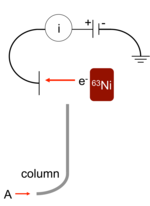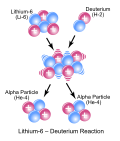 | An electron capture detector (ECD) is a device for detecting atoms and molecules in a gas through the attachment of electrons via electron capture ionization... 7 KB (747 words) - 09:00, 2 March 2024 |
of electron capture ionization. The electron affinity is positive when energy is released on electron capture. In solid state physics, the electron affinity... 22 KB (1,458 words) - 00:23, 5 February 2024 |
 | same. In electron capture, an inner atomic electron is captured by a proton in the nucleus, transforming it into a neutron, and an electron neutrino is... 58 KB (7,025 words) - 11:00, 14 April 2024 |
 | electron capture is a decay mode of an atomic nucleus. For a nuclide (A, Z) with a number of nucleons A and atomic number Z, double electron capture is... 8 KB (854 words) - 10:58, 14 April 2024 |
Electron capture ionization is the ionization of a gas phase atom or molecule by attachment of an electron to create an ion of the form A−{\displaystyle... 9 KB (1,108 words) - 21:14, 22 December 2023 |
 | Tandem mass spectrometry (redirect from Negative electron-transfer dissociation) molecule M. Adding an electron through an ion-ion reaction is called electron-transfer dissociation (ETD). Similar to electron-capture dissociation, ETD induces... 60 KB (7,379 words) - 16:27, 20 April 2024 |
 | Supernova (redirect from Electron capture supernova) type called an electron capture supernova. ... In an electron capture supernova, as the core runs out of fuel, gravity forces electrons in the core into... 199 KB (21,769 words) - 00:32, 23 April 2024 |
 | Radioactive decay (section Electron capture) produces antineutrinos). In electron capture, some proton-rich nuclides were found to capture their own atomic electrons instead of emitting positrons... 96 KB (10,002 words) - 06:47, 22 April 2024 |
 | Positron emission (redirect from Electron capture and beta plus decay) by electron capture. For low-energy decays, electron capture is energetically favored by 2mec2 = 1.022 MeV, since the final state has an electron removed... 9 KB (1,122 words) - 10:56, 4 March 2024 |
with a nucleus containing 26 protons and 29 neutrons. It decays by electron capture to manganese-55 and this process has a half-life of 2.737 years. The... 8 KB (886 words) - 15:37, 16 October 2023 |
 | Internal conversion (redirect from Conversion electron) interacts electromagnetically with one of the orbital electrons of an atom. This causes the electron to be emitted (ejected) from the atom. Thus, in internal... 12 KB (1,699 words) - 04:27, 8 March 2024 |
iodine, after iodine-129. Its half-life is 59.49 days and it decays by electron capture to an excited state of tellurium-125. This state is not the metastable... 16 KB (1,797 words) - 08:48, 11 December 2023 |
 | nuclear orbital in the same way that the pair of electrons in the helium atom occupy a filled 1s electron orbital). Consequently, alpha particles appear... 20 KB (2,392 words) - 20:03, 20 April 2024 |
 | Atom (section Discovery of the electron) accompanied by the emission of an electron and an antineutrino, while proton to neutron transition (except in electron capture) causes the emission of a positron... 121 KB (12,390 words) - 01:50, 24 April 2024 |
 | Chemical ionization (redirect from Electron capture negative chemical ionization) using an electron capture detector coupled to a gas chromatograph. Negative ions are formed by resonance capture of a near-thermal energy electron, dissociative... 16 KB (2,129 words) - 01:40, 15 December 2023 |
 | (MS/MS). Similar to electron-capture dissociation, ETD induces fragmentation of large, multiply-charged cations by transferring electrons to them. ETD is... 16 KB (1,804 words) - 08:57, 2 March 2024 |
quantified as the detector output. In the electron capture mode, the PDD is a selective detector for monitoring high electron affinity compounds such as freons... 3 KB (419 words) - 16:44, 20 February 2019 |
 | Ion source (redirect from Electron beam ion source) by the electron beam ion trap. Electron capture ionization (ECI) is the ionization of a gas phase atom or molecule by attachment of an electron to create... 58 KB (7,140 words) - 08:46, 21 February 2024 |
 | high neutron flux to allow short-lived 45Ca to capture a neutron. 48Ca is produced by electron capture in the r-process in type Ia supernovae, where high... 47 KB (5,908 words) - 10:22, 20 April 2024 |
making up 68.077% of the natural abundance. Possible sources include electron capture from copper-58 and EC + p from zinc-59. Nickel-59 is a long-lived cosmogenic... 19 KB (1,463 words) - 18:54, 11 January 2024 |
 | both beta minus decay and electron capture. Gallium-67 is unique among the light isotopes in having only electron capture as a decay mode, as its decay... 73 KB (8,735 words) - 06:54, 15 April 2024 |
Negative electron affinities can be used in those cases where electron capture requires energy, i.e. when capture can occur only if the impinging electron has... 66 KB (4,066 words) - 08:58, 29 March 2024 |
an electron) with a maximum energy of 1.31 MeV and an antineutrino. In about 10.72% of events, it decays to argon-40 (40Ar) by electron capture (EC)... 8 KB (866 words) - 18:07, 29 February 2024 |
Inverse beta decay (section Electron induced) stars, or in radioactive isotopes capable of electron capture, neutrons are created by electron capture: p + e− → n + ν e. This is similar to the inverse... 7 KB (724 words) - 12:54, 5 January 2024 |
 | Shockley–Queisser limit (section Hot electron capture) the energy of red light, that energy is not captured by devices with a single p-n junction. The electron is ejected with higher energy when struck by... 44 KB (6,215 words) - 05:26, 24 March 2024 |
another body Asteroid capture, when an asteroid is gravitationally captured Electron capture, a nuclear reaction Stream capture, a geomorphological phenomenon... 2 KB (310 words) - 03:51, 21 January 2024 |



